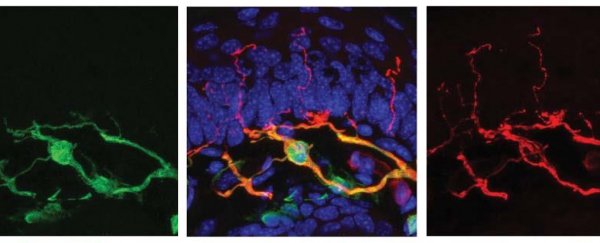Until now, it was thought that the intense feeling we get from jabbing ourselves on something sharp was detected by exposed nerves in the skin. But scientists have just worked out this pain might actually be sensed by a previously unknown organ.
Researchers from the Karolinska Institute in Sweden have identified this unexpected pain detector in mice. They found that many-armed Schwann cells - cells known to protect and support neurons - reach out to each other beneath the outer skin layer (the epidermis) to form a mesh-like network. Meanwhile, their other 'arms' reach up into the epidermis.
Together, along with intertwined pain-detecting nerve cells, these cells work as sensory organ that responds to mechanical pain - such as sharpness, pressure, and burning.
 (Abdo et al., Science, 2019)
(Abdo et al., Science, 2019)
Above: The position of pain receptive Swann cells (red) and nerve cells (blue) in the skin's dermis (d) and epidermis (e).
To test if the newly identified Schwann cells actually contribute to the organ's ability to detect pain, the team used mice, genetically engineered so that only those specific cells could be triggered using light. Sure enough, when exposed to the light stimulus, the mice displayed signs of pain, including jerking their paw away or excessive licking - without having had their nerves or the other types of Schwann cells stimulated by pain.
When the researchers genetically blocked the Schwann cells in this previously unknown organ, the mice displayed a reduced sensitivity to mechanical, but not thermal pain triggers. This suggests at least some, but not all, mechanical pain detection is being processed by these cells, they explain in their paper.
"Nociceptive Schwann cells responded to both positive and negative changes in force but much less to sustained force," the team determined, finding that these cells respond rapidly, like sensory neurons.
Neurobiologist Patrick Ernfors told National Geographic that while the presence of this sensory organ has yet to be confirmed in humans, it is "possible if not likely" to be there, considering we share all the other known sensory organs found in mice.
If that's indeed the case, this discovery could open the way to potential new treatments for the one in five us who experience some form of ongoing pain, and lead to further insights into how and why chronic pain occurs.
But there's a lot about this new organ still left to puzzle out, such as how the Schwann cells and neuron cells interact.
"Our study shows that sensitivity to pain does not occur only in the skin's nerve fibres, but also in this recently-discovered pain-sensitive organ," said Ernfors Ernfors.
"The discovery changes our understanding of the cellular mechanisms of physical sensation and it may be of significance in the understanding of chronic pain."
The team's findings have been published in Science.
